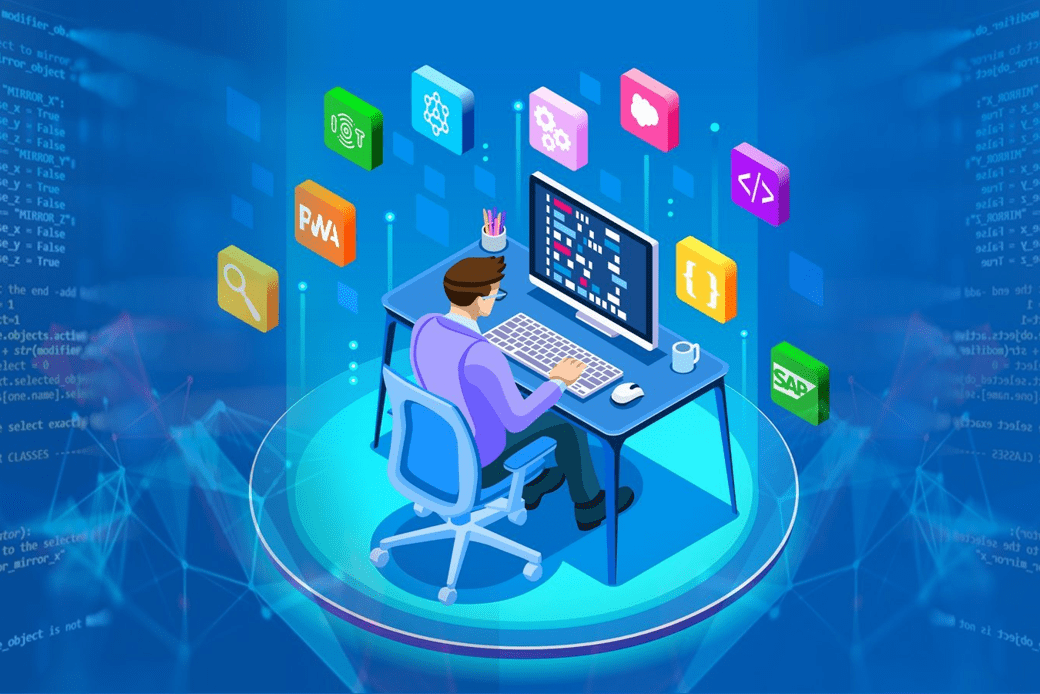In the swiftly evolving landscape of technology, the intricacies of a development team’s composition wield substantial influence over project outcomes. Against the backdrop of technological advancements and dynamic market requirements, the imperative for agile, proficient, and well-coordinated teams has reached unprecedented heights.
This article meticulously dissects the nuances involved in constructing and nurturing a development team that not only boasts technical prowess but also excels in collaborative synergy and innovative thinking. Comprehensive exploration spans understanding intricate team dynamics, ensuring an optimal amalgamation of skills and expertise, and culminating in a detailed developer checklist to fortify your team’s readiness for triumph.
Understanding Team Dynamics
Roles and Responsibilities
A well-structured team is akin to a well-oiled machine, where each part plays a critical role. Key roles include the developer checklist, which is the backbone of creating the product; project managers, who oversee the progress and ensure that milestones are met; and QA testers, who guarantee that the product meets quality standards. A clear definition of responsibilities avoids overlaps and gaps, ensuring efficiency and clarity in the team’s workflow.
Team Synergy
The magic of a successful team lies not just in the sum of its parts but in how these parts work together. Synergy is crucial. It involves building a culture where mutual respect, open communication, and collective problem-solving are the norms. Regular team-building activities and open forums for sharing ideas can foster this environment, leading to a more productive and innovative team.
Skills and Expertise
Technical Skills
In the realm of software development, technical skills are paramount. This includes proficiency in relevant programming languages, familiarity with necessary tools and platforms, and understanding of the latest methodologies like Agile and DevOps. However, it’s not just about having these skills; it’s about continuously evolving them. Encouraging ongoing learning and providing opportunities for skill development are key.
Soft Skills
While technical prowess is essential, the importance of soft skills cannot be overstated. These include effective communication, which ensures that ideas and issues are articulated, and problem-solving, which is critical for tackling the inevitable challenges in development projects. Another essential soft skill is adaptability—the ability to adjust to new conditions and technologies. Assessing and developing these skills can be achieved through regular feedback sessions and soft skill training programs.
Recruitment and Selection

Hiring Strategies
Finding the right talent is a challenge. Effective strategies include crafting detailed job descriptions that attract suitable candidates and utilizing various channels like professional networks, job fairs, and social media. A thorough interview process that assesses both technical abilities and cultural fit is crucial. Behavioral interviews and technical assessments can provide a comprehensive understanding of the candidate’s capabilities.
Diversity and Inclusion
In the intricate realm of team dynamics, diversity is a catalyst for innovation, fostering a spectrum of perspectives beyond ethnicity and gender. Genuine inclusion goes further, embracing diverse thoughts and experiences. This demands not only unbiased recruitment but also a conscientious effort to create an inclusive workplace culture where every team member feels valued. By addressing these facets, including understanding team dynamics and maintaining a strategic skill balance, you set the stage for a development team that excels in competence, collaboration, and innovation.
Case Studies and Industry Insights
Learning from Success
Real-world examples serve as powerful learning tools. This section will delve into case studies of successful development teams from renowned companies. We’ll analyze how their team composition, management strategies, and collaboration techniques led to remarkable project successes. Interactive elements like clickable company logos for more in-depth case study details can enhance user engagement.
Analyzing Failures
Equally important is learning from less successful endeavors. We’ll examine a few instances where team dynamics or skill deficits led to project challenges or failures. This section will include collapsible sections for each case study, allowing readers to explore each example in as much detail as they prefer.
Tools and Resources for Team Management

Project Management Tools
This comprehensive overview will highlight the latest advancements in project management tools, including Jira, Trello, and Asana. Each tool will be meticulously presented with a concise description, optimal use cases, and visual depictions of the interface. This approach not only enhances the content’s readability but also ensures a practical understanding, offering readers a nuanced insight into the functionalities and applicability of each tool.
Communication and Collaboration Tools
Within the dynamic tapestry of the digital era, the significance of effective communication tools cannot be overstated. This examination delves into key platforms such as Slack, Microsoft Teams, and Zoom, meticulously outlining their nuanced features through comprehensive side-by-side comparison charts. By adopting this approach, the analysis aims to facilitate a swift yet thorough understanding, empowering readers to make informed decisions aligned with their specific communication requirements.
Continual Improvement and Adaptation
Team Evaluation Strategies
Ongoing evaluation is key to growth. This section will discuss methodologies for evaluating team performance, including regular feedback sessions, performance metrics, and peer reviews. Interactive polls or quizzes could be embedded to engage readers in self-evaluation.
Keeping Up with Industry Trends
Navigating the ever-evolving tech industry requires staying informed about new technologies and methodologies. We offer insights, recommending online courses, webinars, and industry conferences.
Introducing a monthly ‘Trend Tracker’ feature keeps users updated on the latest tech news. This empowers your team not just for current projects but also for future challenges and innovations. The section concludes with an interactive summary chart, visually mapping key takeaways.
In the swiftly changing landscape of software development, understanding the latest trends and best practices is crucial for staying competitive and effective. Explore the following elaboration on these essential elements for development teams.
Latest Trends in Software Development

- Full-Stack Development: Full-stack developer checklists, skilled in both front-end and back-end development, are increasingly vital for creating high-performing, scalable applications. This role is becoming more sought-after due to the growing dependency on technology
- Python: Known for its versatility, Python remains a popular programming language. It’s used in diverse applications, including AI and machine learning, automation software, and game development
- Cloud Computing: Cloud computing offers accessible, cost-effective alternatives to traditional IT infrastructure. Companies are increasingly leveraging cloud applications like Salesforce and Microsoft Azure for data storage and access
- 5G Networks: The advancement of 5G technology is set to transform digital communication, enhancing user experiences across various devices and potentially revolutionizing how people communicate globally
- No-Code and Low-Code Development: These approaches enable the creation of apps and websites with minimal coding, making the development process quicker, easier, and more cost-effective
- Augmented and Virtual Reality (AR & VR): AR and VR are moving beyond gaming and entertainment, offering innovative solutions for interactive training and e-commerce
- Emerging Programming Languages: Languages like Kotlin, Go, Swift, Rust, TypeScript, and PurseScript are gaining popularity, offering features and support for modern technologies
- DevSecOps: Integrating security as a shared responsibility across IT departments, DevSecOps is crucial for identifying and addressing security vulnerabilities more efficiently
- Artificial Intelligence (AI): AI continues to revolutionize various industries, from chatbots to self-driving cars. Its application in software development increases productivity, reduces human error, and enhances customer experiences, leading to improved business efficiency and reduced operational costs
Best Practices for Software Development Teams

Clear Requirements: Establishing a Software Requirements Specification Document (SRSD) is crucial to define software requirements and design specifications clearly.
Effective Development Process: Employing methodologies like Agile and Waterfall, tailored to project requirements and team capabilities, is essential.
Application Frameworks: Utilizing frameworks saves time and reduces errors, focusing developer checklist efforts on coding rather than repetitive tasks.
Simplicity in Coding: Writing code that is easy to test, understand, and confine to a single domain ensures maintainability and efficiency.
Code Reviews and Pair Programming: These practices enhance code quality, facilitate knowledge transfer, and ensure consistency across the codebase.
Continuous Testing: Implementing continuous testing throughout the development process helps identify and correct errors and bugs early.
Issue Tracking: Employing issue-tracking software ensures early detection and resolution of bugs, preventing costly fixes later.
Continuous Integration: This practice involves merging changes into a shared repository and testing the combined code to reduce bugs and problems.
Version Control: Using systems like Git and GitHub helps manage changes and collaborate effectively, preventing code overwrites and enabling rollbacks.
Sandboxing with Virtual Machines: Virtual machines provide a controlled environment for testing and managing dependencies, adding a layer of protection against vulnerabilities.
Code Signing Certificates: These certificates establish the software creator’s identity and ensure the software’s integrity, protecting intellectual property.
Choosing the Right Software: Selecting software that meets specific development needs and offers the required features is vital for efficiency.
Documentation: Keeping thorough documentation of code changes, issues, and resolutions helps avoid repeating mistakes and facilitates collaboration.
Adherence to Style Guides: Consistent, readable, and maintainable code is achieved by following style guides, which outline coding practices and standards.
Design Before Coding: Planning and visualizing software functionality, user interface, and architecture before coding ensures that software meets user requirements and is scalable.
Feature Management: Introducing features incrementally avoids overwhelming users and allows for thorough testing and refinement.
Separate Environments: Maintaining distinct staging and production environments allows for controlled testing and debugging without affecting users.
Developer Checklist For The Right Team

Ensuring you’ve got the right team is a comprehensive guide that explores the latest trends and best practices in software development. It covers emerging trends such as AI, full-stack development, and 5G networks, emphasizing their impact on the industry.
Essential best practices for software development teams include clear requirements, effective development processes, code simplicity, continuous testing, and version control. Emphasizing the importance of documentation, adherence to style guides, and design before coding.
Additionally, it highlights the significance of feature management and maintaining separate staging and production environments. These insights are crucial for building successful software teams and projects.




